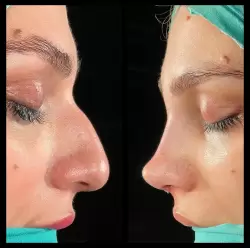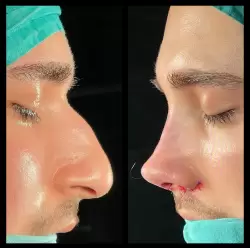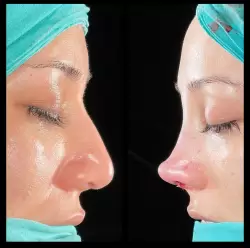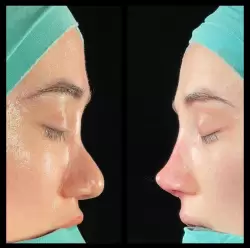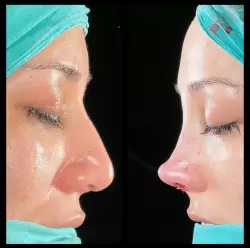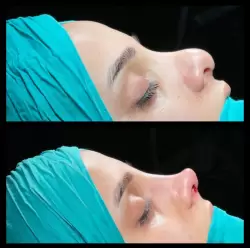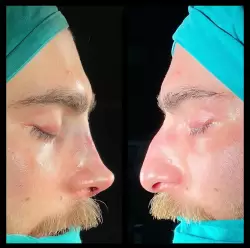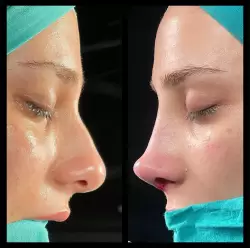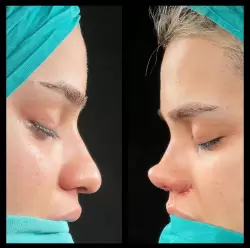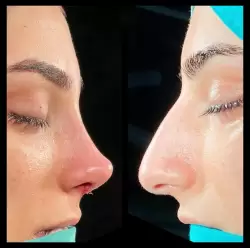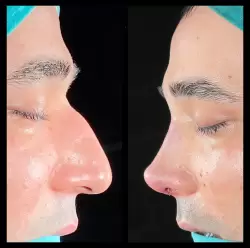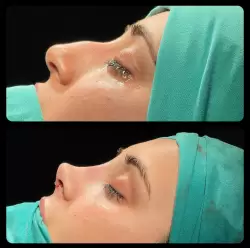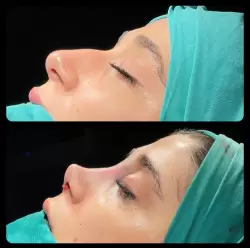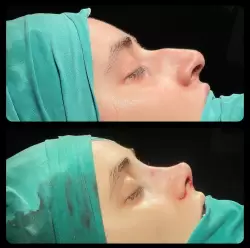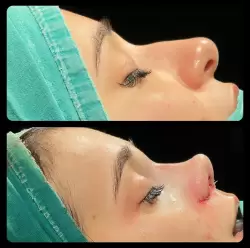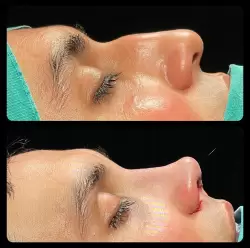Of course, rhinoplasty is a surgical procedure to change the shape and size of the nose. This procedure can be used to correct or alter elements of the nose such as width, length, tip and bumps at the back of the nose. In the past, rhinoplasty could only be performed using open or closed techniques, but today a variety of techniques are available.
Rhinoplasty can be performed not only for aesthetic reasons, but also to correct nasal deformities, to relieve breathing problems or to restore the function of the nose after nasal injury. Although rhinoplasty is safe, it carries risks like any other surgery. For this reason, careful assessment and information about the advantages and disadvantages of the procedure should be provided before surgery.
What is the micromotor method of rhinoplasty?
The micromotor method is a technique used in rhinoplasty surgery. This technique involves the use of a micromotor, an instrument used to shape the nasal bones and provide a more precise approach to rhinoplasty surgery. The micromotor is a small hand tool with a blade that rotates at high speed. This blade is used to shape the bones of the nose. The micromotor method allows for more precise and less traumatic shaping of the nose bones during rhinoplasty procedures.
The advantages of using the micromotor include less bleeding, less pain, less swelling and faster healing during rhinoplasty procedures. In addition, the micromotor method can be used to achieve more precise shaping and a more natural appearance. The micromotor method can be used in conjunction with other techniques to shape the nasal bones. For example, in closed rhinoplasty, a micromotor can be used to shape the nasal bones through small incisions made through the nostrils. The micromotor method is a safe technique for rhinoplasty. However, its use depends on the experience of the surgeon and the correct use of the micromotor.
Things to consider if you decide to have rhinoplasty
There are a number of things that people who are considering rhinoplasty should be aware of before they decide which procedure to have or before they ask their doctor for information. For this reason, those considering rhinoplasty should first consider the following issues
The speciality of the doctor who will be performing the operation: Rhinoplasty is a very delicate procedure and it is important that the doctor who will be performing the surgery is an expert in rhinoplasty.
The level of experience of the doctor: As rhinoplasty is a surgical procedure, it is important to find out about the doctor’s experience, previous surgeries and experience.
Hospital equipment: The equipment to be used during rhinoplasty and the hospital equipment should be adequate.
Health of the person: Before rhinoplasty, the person’s general health should be assessed. If there is an existing health problem, it should be treated before the surgery.
Clarification of expectations: It is necessary to clarify the person’s expectations from the rhinoplasty surgery and establish an open communication with the doctor.
Post-operative care and monitoring: It is important to learn if post-operative care and monitoring will be provided at the hospital and to get information about the healing process.
Complications that can occur after surgery: It is important to learn about the complications that can occur after rhinoplasty, the possible risks, and how to take precautions.
What is the piezo method of rhinoplasty?
The piezo method is a technique used in rhinoplasty. This technique uses ultrasonic vibrations to reshape the nasal bones. Piezo is derived from the Greek word ‘piezein’, a word meaning ‘pressure’. Instead of cutting the bones during rhinoplasty, the piezo method uses ultrasonic vibrations to cut the bones. This method allows for a more precise approach during rhinoplasty and ensures less trauma when cutting the bones.
The piezo method causes less discomfort compared to other methods because it creates less vibration and noise during surgery. In addition, because the blades used to cut the bone are less heated than other methods, there is less exposure to heat, which can speed up the healing process. In rhinoplasty, the piezo method can be used to shape and reposition the nasal bones. In particular, it can be used for procedures such as shaping the tip of the nose, narrowing the nasal bones and correcting protrusions at the back of the nose. The piezo method is a safe technique for rhinoplasty. However, its use depends on the surgeon’s experience and the correct use of the piezo device. The piezo method offers many advantages over other methods of rhinoplasty:
More precise The piezo method offers a more precise approach than other methods by using ultrasonic vibrations to cut the bone. This gives the surgeon a better angle of vision and allows for more precise shaping of the bone.
Less trauma: The piezo method causes less trauma than other methods of cutting bone. This results in less swelling and bruising after surgery.
Less pain: The piezo method causes less pain and discomfort than other methods. This may reduce the need for painkillers in the post-operative period.
Less bleeding: The piezo method causes less bleeding than other methods. This reduces the risk of bleeding in the post-operative period.
Faster healing: Because the piezo method causes less trauma and bleeding than other methods, the healing process may be faster. With less post-operative swelling and bruising, patients can return to their normal activities sooner.
Because of these advantages, the piezo method has become a preferred technique for rhinoplasty. However, as every patient is different, it is best to discuss which method to use with your surgeon.
When are micromotor and piezo methods preferred in rhinoplasty?
In rhinoplasty, micromotor and piezo techniques are generally used for shaping and cutting the nasal bones. Both techniques can be preferred in rhinoplasty surgery in appropriate cases.
The micromotor method is used to cut or shape the bones, while the piezo method is used only to shape the bones. The micromotor method is faster and more effective, but it is noisier and can cause vibrations when cutting the bones. The piezo method is quieter and less invasive as it slowly shapes the bone rather than cutting it.
Rhinoplasty surgeons usually decide which method to use based on the patient’s nasal structure and personal preferences. The micromotor method can be used in cases where more cutting of the nasal bone is required, and the piezo method can be used when a less invasive approach is preferred. In summary, the method used for rhinoplasty may depend on the surgeon’s preference, the patient’s nasal structure and personal preferences.
Frequently Asked Questions About Rhinoplasty
How Long Does Nose Aesthetic Surgery Take?
The duration of rhinoplasty surgery may vary depending on the scope of the surgery, the procedures to be performed and the patient’s condition. Generally, rhinoplasty operations take between 1-3 hours. However, more complex procedures or revision surgeries may take longer. In addition, factors such as the pre-operative preparation process, application of anesthesia and entering the operating room can affect the total time. Therefore, how long the rhinoplasty surgery will take may be different for each patient.
Which Age Range Is Suitable For Nose Aesthetic Surgery?
The appropriate age range for rhinoplasty surgery is generally 18 years and above, after the adolescence period when the nose development is completed. However, in some exceptional cases, it may be necessary to perform the surgery at an earlier age, for reasons such as a congenital deformity of the nose shape or an accidental deterioration. Rhinoplasty surgery is generally recommended to be performed after the adolescence period, when the nose structure of the person is fully developed. The reason for this is that with the completion of the nose structure, the shape of the nose becomes clear and the surgical result becomes more predictable. However, since each person’s nose structure and needs are different, there is no definite rule about the appropriate age range for surgery. Therefore, it is better to consult with your doctor before the operation.
How Long Does the Nose Shape Take After Nose Aesthetic Surgery?
The shape of the nose after rhinoplasty may change during the healing process. The nose may be full of swelling and bruises for the first few days after surgery. Therefore, it may take several weeks or even several months until the nose shape is fully defined. In the first few weeks, the nose may swell due to edema and bruises, which can cause changes in the shape of the nose. During the healing process, the shape of the nose will gradually become clearer and time will be required for the nasal bones and cartilages to settle in place. It is important to be patient and act in accordance with the healing process until the nose shape is fully formed after rhinoplasty.

